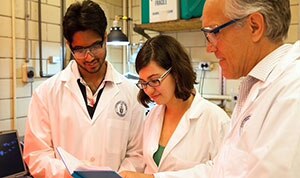NIH LabGenius
Executive Summary
 Scientific research both uses and accumulates a lot of data. Across NIH, thousands of researchers are gathering data through their work. This data is used to explore hypotheses, make conclusions. The data often needs to be shared, combined with other data, or in accessed many months or years after the initially being collected.
Scientific research both uses and accumulates a lot of data. Across NIH, thousands of researchers are gathering data through their work. This data is used to explore hypotheses, make conclusions. The data often needs to be shared, combined with other data, or in accessed many months or years after the initially being collected.
The problem is that data files are kept in multiple places, many lab notes and protocols are written in physical notebooks, and communication is spread across multiple email threads. This leads not only to countless hours lost searching for old data, but also to poor knowledge retention for future members of the organization. Subsequently, this slows the pace of scientific research.
There are a number of platforms and tools out there that are trying to help scientists store, manage, and sharing their data. However, for one reason or another, most NIH scientists don’t use these platforms. Even of those that try out various tools and technologies, most default back to paper notebooks and email.
The Innovation: This team explored two different mechanisms to help NIH scientists better digitize, store, and access scientific data.
“Smart pens”, which write in ink but also store the writing digitally, have been growing in use as their technology improves. This teams conducted a number of experiments to get deliberate feedback from scientists on a couple different models of pens. The questions they explored were “Why don’t more scientists use smart pens?” “Do the smart pens really work as advertised?” “What are the challenges to smart pen adoption?“
The LabGenius team also developed a beta version of a platform that would store the information scribed by the pen. It would also allow for other data to uploaded. Indeed the full vision is that it would be the platform on which scientists store, manage, and share their data.
From the smart pen test trials with scientists, enough interest was developed to convince an NIH working group to explore the issue more formally, conducting a pilot involving multiple labs.
They also had a number of scientists use their beta platform and provide feedback. They’ve begun to focus their use cases of the platform towards scientists looking for help on grants management, data visualization and presentation, and those seeking to integrate other tools for data science.
One important finding is that the issue of data dysfunction, while broadly recognized as an organizational problem, is not a burning issue that everyone wants fixed right away. This makes adoption of any new workflow challenging.
The team is seeking scientists to serve as beta testers to continue to explore the issue and further refine their products.
A project supported by the: HHS Ignite Accelerator
Team Members
John Didion (Project Lead), NIH
Michael Erdos, NIH
Anthony Kirilusha, NIH
Dylan McDiarmid, LittleLoops
Michael Binder, LittleLoops
Milestones
May 2014: Project selected into the HHS Ignite Accelerator
June 2014: Time in the Accelerator began
September 2014: Time in the Accelerator ended
Project Sponsor
Francis Collins, Primary Investigator at the National Human Genome Research Institute & Director of the National Institutes of Health
Additional Information


